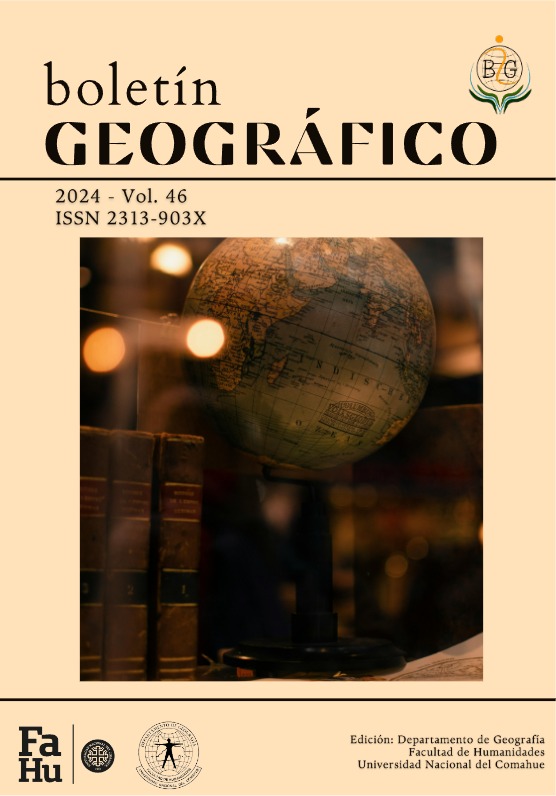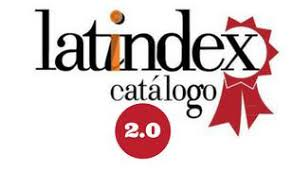Mountainous landscapes and natural hazards. The case of San Martín De Los Andes, Neuquén
Keywords:
Hazard - Exposure - Landscapes - Land usesAbstract
The city of San Martín de los Andes located in the Lacar department of Neuquén province, has experienced significant population growth over the last two decades. This growth has led to the scattered expansion of urban areas, resulting in the establishment of neighborhoods and settlements in areas prone to natural hazards.
The objective of this study is to analyze the dynamics of the natural system by examining various variables (geology, geomorphology, vegetation, hydrography, soils, slopes, land use) to define landscape units. Subsequently, a survey of natural events from the past few decades that caused damage to people or infrastructure was conducted using web media. This made it possible to identify the most critical areas for population, which were later corroborated through fieldwork.
The most hazardous landscape units were found to be those dominated by rocky outcrops and steep slopes composed of colluvial materials from weathering processes. The most frequent events detected were landslides, such as rock falls, debris flows and snow avalanches. The areas with the greatest impact are located on the slopes of the Curruhuinca, Comandante Díaz and Cordón Chapelco hills, due to the high exposure of infrastructure and population. Avalanches are primarily associated with winter activities. Additionally, it is important to note issues derived from flooding and waterlogging that mainly affect neighborhoods located in the Vega Maipú area, as well as part of the historic urban center, where Pocahullo stream overflows. The analysis demonstrated that defining landscape units and recognizing natural hazards provides a crucial foundation for mitigating and preventing risk situations.
Downloads
References
Escosteguy, L. et al (2013). Hoja Geológica 4172-II, San Martín de los Andes. Provincias del Neuquén y de Río Negro. Instituto de Geología y Recursos Minerales, Servicio Geológico Minero Argentino. Boletín 409, 92 pp., Buenos Aires.
Gómez, D. (1994). Ordenación del territorio. Una aproximación desde el medio físico, Madrid: Editorial Agrícola Española. Recuperado de https://info.igme.es/SidPDF/067000/043/67043_0001.pdf
Mardones, M. y Vidal, C. (2001). La zonificación y evaluación de los riesgos naturales de tipo geomorfológico. Revista EURE, XXVII, Nº 81). Chile. Disponible en https://www.scielo.cl/scielo.php?script=sci_arttext&pid=S0250-71612001008100006&Ing
Jurio, E. & Capua, O., (2011). Susceptibilidad del paisaje en la cuenca alta del río Aluminé, Neuquén. En: GeoSIG. Revista digital del Grupo de Estudios sobre Geografía y Análisis Espacial con Sistemas de Información Geográfica. Programa de Estudios Geográficos. Universidad Nacional de Luján, Argentina. Año 3, Sección Artículos: I pp. 54-70. (ISSN 1852-8031). Disponible en https://www.gesig-proeg.com.ar
Kalmbach, R., (2015). Estudio de fragilidad ambiental y expansión de la mancha urbana en San Martín de los Andes. Informe de resultados. Departamento de Geografía, Facultad de Filosofía y Humanidades, Universidad Nacional de Córdoba Subsecretaría de Gestión Ambiental, Secretaría de Planificación y Desarrollo Sustentable, Municipalidad de San Martín de los Andes.
Lavell, A., (1996). Degradación ambiental, riesgo y desastre urbano. Problemas y conceptos; hacia la definición de una agenda de investigación. En: Fernández, M. A. (comp.) Ciudades en riesgo. Degradación Ambiental, Riesgos urbanos y desastres en América Latina. Capítulo 2. La Red.
Mazzoni, E., (2014). Unidades de paisaje como base para la organización y gestión territorial. Estudios Socioterritoriales. Revista de Geografía. 16 (2), 51-81.
Narváez, L., Lavell, A y Pérez Ortega, G. (2009). La Gestión del Riesgo de Desastres: Un enfoque basado en procesos. Perú: Comunidad Andina. Disponible en https://www.academia.edu/11570618/
Ojeda, E. (2019). El anegamiento a través de la prensa: El caso de la ciudad de Corrientes. Boletín geográfico, 41 (2), 13-36. Disponible en https://revele.uncoma.edu.ar/index.php/geografia/article/view/2537/59250
Ortuño Cano, M., Gentili, J., Moretto, B. & Campo, A. M., (2019). Análisis de actores y acciones durante eventos de exceso hídrico (Ventania, Argentina). Boletín geográfico, 41 (1), 53-75.
Pereyra, F., Lara, J., Carut, A., Muñiz Saavedra J., Torre, F., Kalmbach, R., Oliva, R., Salaberry, G., Laffitte, L., Morzenti, P., Rivera, D., Castiñeira, L. y Tobío M., (2016). Estudio geocientífico aplicado al ordenamiento territorial. San Martín de los Andes. Neuquén. Argentina. Instituto de Geología y Recursos Minerales, Servicio Geológico Minero Argentino. Serie Contribuciones Técnicas - Ordenamiento Territorial N° 9. Buenos Aires. En https//repositorio.segemar.gob,ar/handle/308849217/298
Rabassa, J., Coronato, A. & Martínez, O., (2011), Late Cenozoic glaciations in Patagonia and Tierra del Fuego: an updated review. Biological Journal of the Linnean Society, 103: 316-335. https//doi.org/10.1111/j.1095-8312.2011.01681.x
Salinas Chávez, E., (2005). La geografía física y el ordenamiento territorial en Cuba. Gaceta Ecológica, 76, 35 - 51.
Sprechmann, T. (Coordinador) (2013). Plan Maestro Urbano Ambiental de las Zonas de Expansión Periférica de la Ciudad de San Martín de los Andes. Informe Final. Municipalidad de San Martín de los Andes Dirección Nacional de Preinversión-Secretaría de Política Económica del Ministerio de Economía y Finanzas Públicas de la Nación.
Torrens, C., Jurio, E. y Cappelletti, V. (2023). Factores y Actores en la Construcción del riesgo. Interacciones y dinámicas en el ejido de Neuquén, Argentina. Revista de Estudios Latinoamericanos sobre Reducción del Riesgo de Desastres REDER, 7(1), 77-90.
Urra Matus, C y Jurio, E., (2012). Desestabilización de laderas y peligro de procesos de remoción en masa. Caso de estudio: faldeos del Cerro Curruhuinca. San Martín de los Andes. Neuquén. Boletín Geográfico. 34, 77 - 89.
Werner, F., (2007). San Martín de los Andes. Perspectivas del ambiente urbano. Ingeniería en Ecología. Proyecto Final. Facultad de Ingeniería. Universidad de Flores. Buenos Aires.

Published
How to Cite
Issue
Section
ARK
License
Copyright (c) 2024 Boletín GeográficoTransfer of rights and data processing
The acceptance of an article for publication in the Journal Geographic Bulletin implies the cession of the rights of printing and reproduction, by any means and means, of the author in favor of the Department of Geography of the National University of Comahue, which will not reject any request reasonable for the authors to obtain permission to reproduce their contributions. The total or partial reproduction of the works published in the Geographic Bulletin must be done citing the origin, otherwise, the copyright is violated.
Likewise, it is understood that the concepts and opinions expressed in each work are the sole responsibility of the author, without being responsible or in solidarity, necessarily, neither the editorial staff nor the editorial staff.
It is the responsibility of the authors to be able to provide interested readers with copies of the raw data, procedure manuals, scores and, in general, relevant experimental material.
Likewise, the Management of the journal guarantees the appropriate treatment of personal data
COPYRIGHT TRANSFER FORM
















 Journal of the
Journal of the 